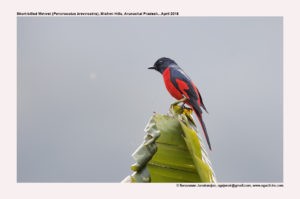
Short-billed Minivet Pericrocotus brevirostris
Etymology:
- Pericrocotus : Greek word for perivery, all around; krokotos-golden-yellow derived from krokos- saffron
- Brevirostris : Latin word for brevisshort; rostris—billed { Short billed}
Vernacular Names: Kash: Wozul mini, Ass: Lali raja sorai, Cachar: Dao ribi kashiba
Distribution in India: Widespread Resident India.
Description: Size of 15-16 cm. The male of nominate race has dark grey on lores, face to above eye, ear-coverts and chin to lower throat; forehead to back and scapulars paler grey, rump and uppertail-coverts rich reddish orange; upperwing sooty black, greater coverts tipped orange, remiges with yellow flash on primaries, pale orange on secondaries; innermost two rectrices sooty black, outer four mainly pale orange; breast bright orange, shading to yellow on belly and creamy yellow on undertail-coverts; underwing-coverts pale yellow; iris dark brown; bill and legs black. The female differs from male in having whitish forehead, narrow pale supercilium from base of bill to eye, white eyelids, paler grey crown to back and scapulars, duller orange rump (tinged olive), wing markings all yellow, much reduced on greater coverts, throat whitish, underparts greyish white with yellow suffusion.The juvenile is like female, but upperparts are scaled yellowish, upperwing-coverts tipped are yellowish-white, side of throat, breast and flanks are spotted and barred grey-brown, underparts are less extensively yellow, more whitish. The immature is like female, but young male are more orange-yellow on underparts and orange on wings and tail. The races differ mainly in plumage of female: affinis(Assam and Arunachal Pradesh) female has less yellow on head.
Habitat: It is found in forest, woodland, mangrove forest, thorn-forest, strand woodland, casuarinas, scrub, orchards and other cultivated lands; sometimes occurs around villages. Prefers more open wooded habitats than those occupied by most congeners.
Food Habits: Its eats moths and caterpillars and other insects, including beetles and cicadas. It forages in parties in canopy; often joins mixed-species parties. Gleans leaves, and makes short sallies to catch flying prey.
Breeding Habits: They breed in Apr–Jun in Himalayas and Feb and Jun–Oct in peninsular India.The nest is constructed by both sexes over period of 7 days. The nest is a small, deep, neat cup of fine twigs, grass stems, lichens, dead leaves or bark, lined with rootlets and bound with cobwebs, attached to tree branch or fork above ground. They lay a clutch of 2-4 eggs. The incubation period is 11 days .The incubation is done by female provisioned by male. The fledging period is 12 days. The young fed by both sexes.